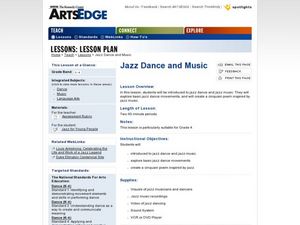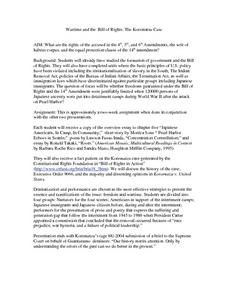Curated OER
Island of the Blue Dolphins Jigsaw
Fourth graders research three topics from the book, either Village Life, Sea Life, or San Nicholas Island. They research independently and meet in a jigsaw format to share what they learned. As group they create a poster for class...
Curated OER
Jazz Dance and Music
Fourth graders write a poem. For this jazz music lesson, 4th graders learn about the basics of jazz dance and practice basic movements. Students learn common terminology and listen to several recordings of jazz music. Students create a...
Curated OER
Critically Examining, Analyzing and Evaluating Picture Books on Aboriginal Canada
Students combat pervasive stereotypes. In this Critical Analysis lesson plan, students examine and evaluate the stereotypes of Aboriginal groups, as depicted in a picture book. Students will use primary and secondary sources to compose...
Curated OER
History in Pictures
Sixth graders interpret diary entries, letters and read maps to better understand portions of history. They create an oral presentation demonstrating understanding of how cultural characteristics have been communicated through art,...
Curated OER
GAURI AND PRITHVI: THE SUB-CONTINENT GOES NUCLEAR
Students write short papers on the background of the Pakistani missile called Gauri, named for one of the first Afghan military invaders of India in 11th century, Prithvi is named for Hindu general who fought Muslim invaders, Agni (Hindu...
Curated OER
Black Hawk Island Hike
Students explore Wisconsin's natural and cultural history through hands-on exploration of Upham Woods. They are shown the basic paddling skills and they work in teams to paddle across the river on barge. Students describe cultural...
Curated OER
The Lewis and Clark Expedition
Students study westward expansion. In this US history lesson, students describe the adventures and hardships faced by the explorers known as Meriwether Lewis and William Clark. Students write a report to the President about the journey...
Curated OER
Navajo Code Talkers of WWII
Eighth graders assess different ways that significant individuals and events influenced economic, social and political systems in the United States after 1880. They experience a Navajo code talker's dictionary to create and decode messages.
Curated OER
Push and Pull Factors on Migration
Students investigate push and pull factors. In this population trends lesson, students examine primary sources that help them comprehend how push and pull factors have changed over time.
Curated OER
Federalist and Antifederalist Papers
Students debate the Federalist and Anti-federal Papers after using the Internet as a research tool.
Curated OER
Part-Part-Whole
For this math worksheet, students color pictures to show that a whole number is a combination of two smaller parts. Students listen as their buddy demonstrates telling about the pictures, example: "I see one blue balloon and three red...
Curated OER
Hawaii's Future Tied to History
Students investigate Hawaii's history to help them explain how a Reorganization Act may affect its residents. students track the region's history from statehood, to kingdom, to human settlement.
Curated OER
Boarding School vs. Day School Experiences
Pupils compare and contrast the lives of Hopi children that attend boarding school and those that attend day school. In this schools lesson plan, students understand changes over time as they look at these schools chronologically.
Curated OER
Mother Earth
Students compare natural and human made items and gain an awareness of the importance of Mother Earth to the Nez Perce people.
Curated OER
Jefferson Administration
Students research the major domestic issues that were present during the administration of Thomas Jefferson including the acquisition of the Louisiana Territory, Lewis and Clark's expedition, and his foreign policy. They investigate...
Curated OER
The Kansas Flag
First graders study the symbols on the Kansas flag. In this social studies instructional activity, 1st graders read about the symbols on the state flag. Students create a flag folder and complete word work assignment for each of the...
Curated OER
Protecting Land
Students complete the Protecting Land anticipation guide. They use Internet to research land ownership in Alaska.
Curated OER
What Was It Like?
Students use the Internet to gather historical facts about the county in which they live. Using the information, they discover how to check it for accuracy and present their findings to the class. They write an essay about the history of...
Curated OER
We're Finally on our Own: May 4, 1970
Students examine photos of the Kent State University unrest of the 1970's and discuss what the photos represent. They complete a written assessment.
Curated OER
Wartime and the Bill of Rights: The Korematsu Case (Lesson 2)
Twelfth graders review how the government and Bill of Rights came into effect. Using primary source documents, they discuss if Japanese rights were violated when they were placed in internment camps after the bombing of Pearl Harbor. ...
Curated OER
All Men Are Created Equal
Learners discuss the statement "All Men Are Created Equal". Using the internet, they research events in history in which this statement has been ignored and supported by the government. They use this information to write an essay about...
Curated OER
Understanding Treaties: Students Explore the Lives of Yakama People Before and After Treaties
Students examine the impact of treaties on the Yakama nation. They discover the importance of land and how they felt when their land was taken away. They role-play the positions of both the Yakama and citizens of the United States.
Curated OER
Whose Rock Is This Anyway?
Students will seek to understand the events at Pipestone Quarry and what may have caused them. Pipestone Quarry in Pipestone, Minnesota, bears the mythic red Sioux quartzite called Pipestone or Catlinite.
Curated OER
Our Goal Pole
Studnets discuss the meaning of exploration and investigate a map of the Louisiana Territory. They discuss Lewis and Clark's expedition and complete worksheets. They create a "goal pole" that represents their learning.

























